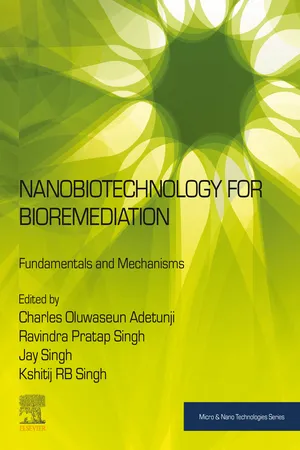
Nanobiotechnology for Bioremediation
Fundamentals and Mechanisms
- 364 pages
- English
- ePUB (mobile friendly)
- Available on iOS & Android
Nanobiotechnology for Bioremediation
Fundamentals and Mechanisms
About This Book
Nanobiotechnology for Bioremediation: Fundamentals and Mechanisms provides detailed information on nanomaterial applications for the bioremediation of a heavily contaminated environment. Relevant information is provided on the application of nanofibers, nanoscale zero-valent iron (nZVI), nanocomposites, and carbon nanotubes to rejuvenate the environment from different pollutants, such as heavy metals, chlorinated compounds, organic compounds, polyaromatic hydrocarbon, and hydrocarbons. The book also explores the application of nanomaterials as a sustainable green solution that helps prevent various high levels of contamination in the environment.
Each chapter addresses the application of nanomaterials as a sustainable tool for managing innumerable environmental challenges. This helps readers translate their research findings into sustainable innovations to resolve their immediate environmental challenges.
- Provides information on nanomaterial utilization for bioremediation of soil and water heavily polluted with pesticides and heavy metals
- Outlines novel nanomaterials that could serve as adsorbents, especially in managing heavy metal–polluted wastewater
- Explores nanomaterial applications derived from microorganisms via immobilizing or through novel remediating microbial enzymes
Frequently asked questions
Information
Table of contents
- Cover image
- Title page
- Table of Contents
- Copyright
- Dedication
- List of contributors
- Editors’ biographies
- Preface
- Acknowledgments
- 1. Introduction: utility of nanobiotechnology for bioremediation
- 2. Nanofibers’ utility for rejuvenation of heavily contaminated environments
- 3. Nanoscale zero-valent iron (nZVI) for rejuvenation of heavily contaminated environment
- 4. Bionanocomposites for rejuvenation of heavily contaminated environment
- 5. Carbon nanotubes for rejuvenation of heavily contaminated environments
- 6. Utility of biogenic nanomaterials for rejuvenation of heavy metals
- 7. Novel nanomaterials via microorganisms for bioremediation
- 8. Smart and intelligent bionanomaterials as adsorbents for management of heavy metal–polluted wastewater
- 9. Potentialities of biogenic nanomaterials for bioremediation of pesticides
- 10. Removal of chlorinated compounds using bionanomaterials
- 11. Bioremediation of PAHs using nanotechnology
- 12. Mode of the mechanism of biogenic nanomaterials involved in the adsorption of pollutants
- 13. Ecofriendly biocomposites for the remediation of contaminated marine water by solvents and organic oils
- Index